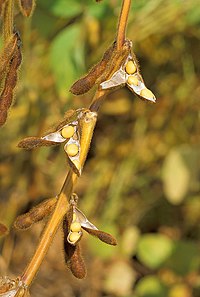
Photo from wikipedia
Soybeans [Glycine max (L.)] are a good source of isoflavones. The main isoflavone components of soybean are daidzein, genistein, and glycitein. World soybean production is very high. Because of its… Click to show full abstract
Soybeans [Glycine max (L.)] are a good source of isoflavones. The main isoflavone components of soybean are daidzein, genistein, and glycitein. World soybean production is very high. Because of its pharmacological activity, soy isoflavone intake over a long period of time may result in interactions with the drugs. This review summarizes soy isoflavone-drug interactions based on the pharmacokinetic parameters. Soy isoflavones have pharmacokinetic interactions with celecoxib, theophylline, paclitaxel, midazolam, imatinib, carbamazepine, valproic acid, repaglinide, omeprazole and danofloxacin. This is due to the changes in the area under the curve, maximum serum concentration, time that a drug is present at the maximum concentration in serum, clearance and half-life of the drugs when delivered together with soy isoflavones. The mechanisms of pharmacokinetic interactions occurs through the inhibition/induction of drug metabolizing cytochrome P450 (CYP450) enzymes such as CYP3A4, CYP2A1, and CYP2C9 or through the inhibition of drug transporters such as P-glycoprotein and breast cancer resistance protein. Thus, the consumption of soybean, soy isoflavones or soy products with drugs needs to be reconsidered.
Journal Title: Turkish journal of pharmaceutical sciences
Year Published: 2021
Link to full text (if available)
Share on Social Media: Sign Up to like & get
recommendations!